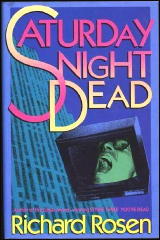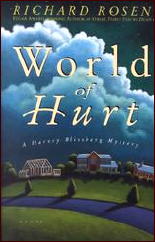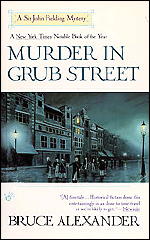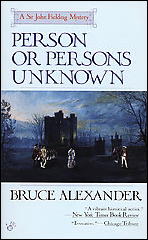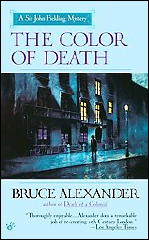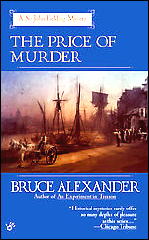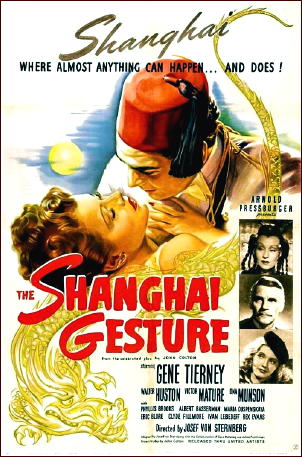August 2009
Monthly Archive
Tue 11 Aug 2009
Posted by Steve under
Reviews[5] Comments
FORGOTTEN MURDERS #1
by Allen J. Hubin
DIPLOMAT – Murder in the State Department. Jonathan Cape & Harrison Smith, US, hardcover, 1930.
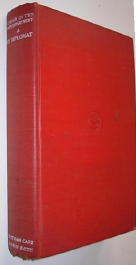
John Franklin Carter wrote books on a variety of subjects under several pen names, including Unofficial Observer and Jay Franklin. But when in 1930 he began a series of detective novels about a diplomat-detective, Dennis Tyler, he chose his pen name, Diplomat, with malice aforethought.
Many of the titles of his books about Tyler suggest a political setting — for example, in addition to the above, Carter wrote Murder in the Embassy, The Corpse on the White House Lawn, Death in the Senate, and Slow Death at Geneva.
Carter’s interest in politics and diplomacy is also apparent in his nonfiction books under the Jay Franklin pseudonym — for example, he wrote a biography of La Guardia.
A recent reading of Murder in the State Department suggested that Carter’s detective fiction might be worthy of rediscovery. Undersecretary Harrison Howard is found with a steel filing spike in his chest, and Dennis Tyler, Chief of the Bureau of Current Political Intelligence, jauntily arrives on the scene. Tyler, who affects a Harvard accent and abundant sassy repartee (for which I must confess a weakness), puts his career on the line in his effort to solve the crime.
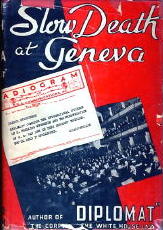
The case involves, among other things, an undersecretary seen flying down the nocturnal halls of the State Department with no visible means of support, the latest discovery by the Chemical Warfare Service, and finally a sinister plot by a national pacifist leader to take over the country (shades of Fu Manchu!).
The book is weakened by an unsatisfying ending, but the author’s style is brisk and the action incessant.
As long as credibility is not required, Murder in the State Department makes very entertaining reading and I look forward to investigating other Diplomat books in my library.
– From
The Armchair Detective, Vol. 1, No. 1, October 1967.
[UPDATE] 08-12-09. From the second issue of TAD [January 1968] is the following News Note, signed by AJH [Al Hubin] —
In the first issue of The Armchair Detective a novel by John Franklin Carter was reviewed, and it was suggested that Carter’s detective fiction, written in the 1930′ s under the pseudonym Diplomat, was worthy of rediscovery. Mr. Carter died November 27 at the age of 70, and thanks to Charles Shibuk I am in possession of obituary notices from the New York Times and the New York Post.
Mr. Carter was born in 1897, one of a family of 7 children of Rev. John Franklin Carter, an Episcopal clergyman, and his wite. Weakened health due to a serious childhood infection caused him to learn to write “in self-defense against a world which is, among children at least, thoroughly contemptuous of weaklings.”
He was occupied in various phases of newspaper work during his twenties, and then, beginning in 1928 when he moved to Washington, concerned himself with politics and government service for the rest of his lite. He held posts in the Departments of State and Agriculture, and commented on political life on radio programs and in newspaper columns for many years. Most of his more than 30 books dealt with politics, but it is interesting to note that although considerable space was devoted in the newspapers (especially the Times, on whose staff Carter served for some 5 years) and in Time Magazine to his obituary none of these publications said one word about his detective fiction.
Tue 11 Aug 2009
Posted by Steve under
ReviewsNo Comments
THE BACKWARD REVIEWER
William F. Deeck
WHITMAN CHAMBERS – Dead Men Leave No Fingerprints.
Doubleday, hardcover, 1935. Hardcover reprint: Caxton House, 1939. Paperback reprint: Detective Novel Classic #28, circa 1943.
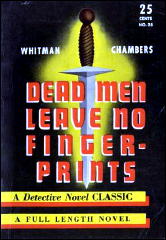
Danish film star and sexpot Hilda Haan hires private detective Stanton Lake to get her out of the clutches of a man who threatens to tell her studio about her “moral turpitude” unless she marries him. Lake says he’ll get her out of the mess if he has to kill the man to do it.
That turns out to be unnecessary. Someone else does the job for him while preparations are being made for a seance at the residence of Rufus Raybourne, a real-estate magnate now suffering hard times. The victim is killed with a poker that has on it the fingerprints of an enemy of Raybourne’s.
Yet this enemy died more than a year earlier in prison. Or did he? Lake plays ghoul and finds an empty grave. Two more murders take place. After each one, the same fingerprints are found.
An unusual motive, a cunning — well, he or she would have been if the killings hadn’t continued once Lake’s identity was revealed — murderer, and an interesting character in Lake.
The writing level is the ’30s standard: Passable.
– From The MYSTERY FANcier, Vol. 10, No. 3, Summer 1988.
Tue 11 Aug 2009
A 1001 MIDNIGHTS Review
by Kate Mattes:
R. D. ROSEN – Strike Three, You’re Dead. Walker, 1984. Signet, pb, 1986. Walker, trade pb, 2001.
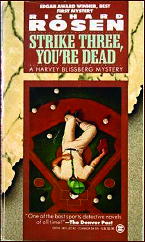
Harvey Blissberg, the hero of Strike Three, You’re Dead, is a baseball player recently traded from the Boston Red Sox to a new American League expansion team, the Providence Jewels.
Called “Professor” by his younger teammates for his reading habits and off-diamond attire, Blissberg is stumped for a motive to the murder of his roommate, Rudy, and begins looking for the murderer out of a combination of curiosity and guilt.
Discouraged by management, teammates, and police, Blissberg gets support from his girlfriend, a local TV sportscaster, and his brother, a baseball fanatic, as he tries to determine why his best friend on the team wound up drowned in the team whirlpool. His quest for the murderer takes on a new urgency when he, too, becomes a target.
Baseball statisticians will have a very slight edge in solving the murder, but such avidity is not needed. Rosen’s clever plotting, quick wit, and subtle understatement makes this book both entertaining and easy to read.
In the second book in this series, Fadeaway (1985), Blissberg has retired to become a professional detective and is called in to solve the murder of two NBA basketball stars.
Strike Three, You’re Dead was named one of the seven best mysteries of the year by the New York Times, and won a Best First Novel Edgar. Rosen is also the author of two nonfiction books and numerous essays, criticisms, and articles on sports and humor.
———
Reprinted with permission from 1001 Midnights, edited by Bill Pronzini & Marcia Muller and published by The Battered Silicon Dispatch Box, 2007. Copyright © 1986, 2007 by the Pronzini-Muller Family Trust.
Tue 11 Aug 2009
A REVIEW BY FRANCIS M. NEVINS, JR.
RICHARD ROSEN – Fadeaway. Harper & Row, 1986. Paperback reprint: Onyx, July 1989.
– Reprinted from The MYSTERY FANcier, Vol. 9, No. 2, March/April 1987.
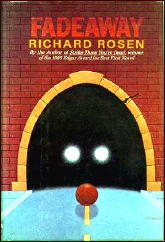
Robert B. Parker may not be the best private eye writer of the eighties but surely he’s the most influential, as witness the horde of newcomers to the field who have used his pretentious, wildly overrated, consistently best-selling series about the Boston PI Spenser as their takeoff point.
Richard Rosen, winner of the Mystery Writers of America Edgar award for the best first crime novel of 1985, deserves another prize for. using Parker most creatively.
The main character both in Fadeaway and in Rosen’s prizewinning Strike Three You’re Dead is a sort of Jewish Spenser, at least in the sense that each man is a smart-mouthed jock from Boston with a liberated live-in lady and a snootful of angst.
Harvey Blissberg has turned hesitantly to the PI game after the early end of his career as a major-league outfielder, but he’s not very good at his new line of work and all his cases seem to come to him from his sports world connections. In Fadeaway he’s hired simultaneously by the Boston Celtics and the Washington Bullets to find out why a basketball star from each team vanished from Logan Airport within forty-eight hours of one another.
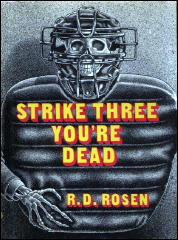
When both players are found shot to death, Harvey follows the trail into the seamy world of college sports recruiting, and his hunch that the murders are tied in with the seven-year-old “accidental” death of a high school basketball champ in a dark bus tunnel stirs up the usual hornet’s nest of corruption.
If Ross Macdonald had written this book, the plot would have been so convoluted you’d need a chart to sort out who did what to whom. Rosen goes to the opposite extreme, leaving out complexity and surprise almost entirely.
If Parker had written the book, there would have been a violent confrontation in every chapter. Rosen avoids action scenes almost entirely, too. But he’s an excellent stylist, with the ability to describe an American city (in this case Providence, Rhode Island) and the inner world of desperately lonely people as well as any PI novelist now at work.
What sets Rosen apart from everyone else in the field, however, is his gift for shifting without effort from the film noir gear into another mode entirely. Here for example is Harvey anguishing over the case with his girlfriend, Mickey:
“I can’t figure out where their lives crossed. Christ, Mick, what am i going to do? I’m out of my element.”
“You never had an element.”
“Thanks. You’re joking and I’m having a crisis.”
“Life is a series of crises.”
“It hasn’t always felt like this.”
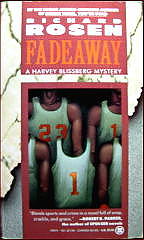
“Okay, I take it back. Life is a series of crises separated by brief periods of self-delusion.”
“I need a pith helmet to protect me from your sayings.”
Jock though he’s supposed to be, Harvey is the only PI in the literature who cries out to be played by Woody Allen.
Fadeaway is crammed with scenes which are not only hilarious in their own right, but marvelous as parodies of the tiresome philosophic shticks in the Spenser novels. It’s light on action and complexity, but the first-rate dialogue and characterizations and the rich anti-Parker subtext make this one a joy to read.
Bibliography — Expanded from the Revised Crime Fiction IV, by Allen J. Hubin:
ROSEN, R(ichard) D(ean), 1949- . SC: Harvey Blissberg, in all titles.
Strike Three You’re Dead. Walker, hc, 1984. Signet, pb, 1986. Walker, trade pb, 2001.
Fadeaway. Harper & Row, hc, 1986; Onyx, pb, 1989.
Saturday Night Dead. Viking, hc, 1988; Onyx, pb, 1989.
World of Hurt. Walker, hc, 1994.
Dead Ball. Walker, hc, 2001.
Mon 10 Aug 2009
BRUCE ALEXANDER – Rules of Engagement.
Berkley, paperback; 1st printing, February 2006. Hardcover edition: G. P. Putnam’s Sons, March 2005.
This is the first of Bruce Alexander’s “Sir John Fielding” detective novels that I’ve read, and no, I didn’t realize it until after I’d picked it out to read that this is also the last one that Alexander ever wrote. And as perhaps you already knew, Bruce Alexander was the pen name of Bruce Cook, 1932-2003, who wrote eleven mysteries under that name. Under his own name, he had five earlier ones, four of them with Antonio “Chico” Cervantes as the leading character.
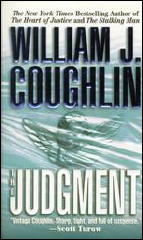
Now it gets interesting. (I’ll get back to Antonio “Chico” Cervantes in a minute.) Cook also was at least in part responsible for writing William J. Coughlin’s last book after he (Coughlin) died, The Judgment (St. Martin’s, 1997). I’m quoting from Al Hubin in Crime Fiction IV now: “Apparently written by Bruce Cook from a beginning by Coughlin, then finished and polished by widow Ruth Coughlin.”
The reason is that this is interesting, is that this is precisely how Rules of Engagement got written. From the back cover, and quoting again: “He (Bruce Cook) died in 2003, having completed most of Rules of Engagement, and left notes on how the rest of the story unfolded. John Shannon, author of the highly praised Jack Liffey series, most recently Dangerous Games, completed the novel with Bruce’s wife, Joan Alexander.”
As coincidences go, it would be rather minor, but was it a coincidence? Probably not. The idea was there, and the Bruce Cook and his wife simply carried it out in the same way it had been done before. And as you can easily imagine, there are both pluses and minuses in doing so.
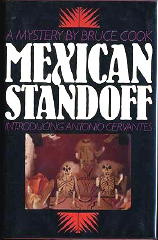
But before getting into that, and to Sir John Fielding and what the book (and the series) is about, I promised to tell you something about Chico Cervantes. This Thrilling Detective link will tell you more, but perhaps it suffices to say that Cervantes was a Mexican-American ex-LA cop turned private eye whose stomping grounds were (as you probably already guessed) Southern California.
His four recorded cases, published between 1988 and 1994, did not seem to turn the mystery fiction world on fire, and in fact, only one of the four, the first, Mexican Standoff, was ever published in paperback, the other three only in hardcover.
For whatever that tells you. In any case (no pun intended) the year the last Cervantes book came out, 1994, was the same year that Blind Justice, the first Sir John Fielding novel appeared. Cook, as Alexander, at the age of 62, had hit the equivalent of pay dirt.
I’ll append a complete list of the highly popular Fielding books at the end of this review. (I have them all. They are, unfortunately, still in the TBR (To Be Read) portion of the basement.)
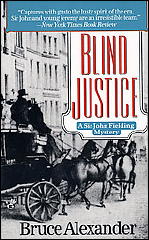
Sir John Fielding, as I hasten now to tell you (at last), was the blind English magistrate who was the real-life founder of London’s first true police force, the Bow Street Runners, in the mid-to-late 1700s.
What’s interesting about one of Alexander’s Fielding books, An Experiment in Treason, Benjamin Franklin makes an appearance. Unlike Robert Lee Hall’s series of books of the latter’s London adventures, though, in Treason Franklin is a suspect, not the detective, while in Hall’s books, Fielding is only a (relatively) minor character.
In the books by Bruce Alexander, Fielding’s household and close-knit circle of friends and close acquaintances takes center stage, filled to abundance with family, servants, many of which (if not most) are fictional. Especial note should be made of the narrator of the tales, one Jeremy Proctor, Fielding’s protege with him throughout the series, an orphan taken under his wing as a dogsbody, now in Rules of Engagement all of eighteen and Sir John’s clerk at the Bow Street Court.
The title comes in part from the fact that Jeremy is engaged to be married to Clarissa Roundtree, the other orphan taken in by the Fieldings: Clarissa as Lady Fielding’s general factotum, and as the book begins, he (Jeremy) is beginning to wonder greatly about his future. (On page 241 there is another context in which “rules of engagement” come into play.)
The mystery is extremely slight, but of course it needs to be mentioned. It concerns the strange death of Lord Lammermoor, who has recently jumped to his death from a bridge while crossing the Thames alone.
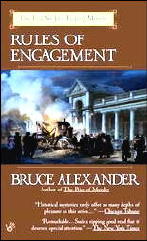
Several chapters later (or to be precise, in Chapter Three) the case is all but solved when Fielding and his entourage are entertained at the theater by a practitioner of “animal magnetism” and/or “mesmerism.” The only question that remains (to the reader, that is) is who is responsible, and while I cannot reveal his/her name, you will know as soon as he/she enters the story. (Ventriloquy is also an important factor, but my telling you that will neither enlighten you further, or less.)
One hopes for more, but more there is not, save 200 pages in which a great happens, but very little of any consequence. All in all, what the authors in combination have provided is nothing less than a worthy attempt to tie up some loose ends for the readers who followed the series and the characters from early on — but not all of them (the loose ends, that is). Life happens, and that is what is left for the reader to contemplate. This is one of the aforementioned pluses.
For someone expecting a detective story with some solid, down-to-earth detective work going on, either Mr. Alexander did not have one in mind, or if he did, neither his wife nor John Shannon were able to build one out of the notes that he left them. This is one of the aforementioned minuses.
For the record, the pluses outweigh the minuses, but personally, coming in at the end as I did, I left with a feeling of disappointment that I sincerely wished I hadn’t — come in at the end, that is.
If you’d like to call my verdict “mixed,” you’d certainly be right. I wouldn’t deny it at all.
— March 2006
The Sir John Fielding novels by Bruce Alexander:
All were published in hardcover by Putnam and in paperback by Berkley. The dates are of the hardcover editions; the paperback generally appeared a year later.
Blind Justice. 1994.
Murder in Grub Street. 1995.
Watery Grave. 1996.
Person or Persons Unknown. 1997.
Jack, Knave and Fool. 1998.
Death of a Colonial. 1999.
The Color of Death. 2000.
Smuggler’s Moon. 2001.
An Experiment in Treason. 2002.
The Price of Murder. 2003.
Rules of Engagement. 2005.
Mon 10 Aug 2009
Posted by Steve under
ReviewsNo Comments
A REVIEW BY DAVID L. VINEYARD:
RUSSELL KIRK – Old House of Fear. Fleet, US, hardcover, 1961. Hardcover reprint: Detective Book Club, 3-in-1 edition, October 1961. Paperback reprint: Avon G-1134, 1961. Trade paperback: Eerdmans, April 2007.
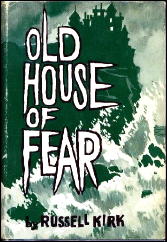
This unblushing Gothick tale by conservative economist Russell Kirk is a grand thriller with echoes of Buchan, Bram Stoker, and Daphne Du Maurier, and contains one of the great villains in the literature, the magnificent Dr. Jackman.
Hugh Logan, an American lawyer and veteran born in Edinburgh is dispatched by industrialist Duncan MacAskival to purchase his ancestral home on the wild Scottish island of Carnglass. “Old House of Fear, I like the names. You’re to buy Carnglass for me, cliffs and clachans and deer-forest and Old House and all: and price is no object.”
The MacAskival castle, a gray mass of stone and disparate architecture is known as the Old House of Fear, and in Gaelic, fear or “fir” means man.
Almost from the minute he sets foot on Carnglass Logan finds himself facing intimations of danger. Lady MacAskival who owns the castle is a tough old bird under the dire influence of the mysterious Dr. Jackman, who has manned the place with IRA thugs and filled the cellars with explosives.
Jackman, a Marxist, was a torturer for the party during the Spanish Civil War and later did something so horrible in Rumania that he was driven out by his masters:
Jackman was a man who had once known good and had deliberately chosen the evil — and ever after had been haunted by that memory. “Evil be thou my good.” Fearless and very clever, somewhere early in life he must have taken some sinister track. And never had he contrived to look back.
Jackman wants the Old House of Fear for himself and the hand of young Mary MacAskival for her money, so he is less than happy when Logan shows up posing as her fiance, a bank teller from Edinburgh, as his only way to get into the armed fortress Jackman has made of the house.
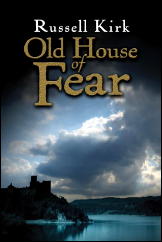
As Kirk piles incident on incident and raises the atmosphere to the highest level, Jackman and his men, led by the soulless killer Royal, are pitted against Logan, Mary, Mac MacAskival the young heir, and a handful of villagers from the far side of the island, with the simple giant Angus, who Jackman has tortured, a question mark in the dangerous game that is rapidly coming to a head.
Meanwhile Kirk draws the characters in three dimensions, none of them existing only for the purpose of the book, but all fully drawn characters, none more so than Jackman, a man who has come to relish evil:
“Have you ever heard a lady scream?” Dr. Jackman asked Logan. “A full-throated scream, from exquisite agony, I mean.
“Imagine a gently-bred, soft skinned young lady who hadn’t had a hand laid on her since she was a naughty child; then think of her treated to the worst that the human body can stand. How she would scream, Logan, and babble and beg, and you would have the exquisite experience of watching, unable to intervene.
“Suppose Miss Mary MacAskival were the young lady?
“Torment is the great leveler, Logan. In torment the Colonel’s lady and Judy O’Grady are sisters under the skin. Their are no class distinctions in agony. Our Miss MacAskival would behave like the lowest trull from Piccadilly, except she would scream louder and longer …”
Hugh Logan set perfectly still, almost hypnotized by Dr. Jackman’s rich voice and shining, marvelous eyes. He wondered what strange species of animal this Dr. Jackman was. Brilliant yes; articulate, acutely sensitive — but he was evil, Hugh realized. Evil, and utterly, dangerously, mad…
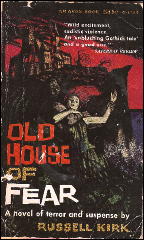
Kirk was well known for his tales of the supernatural, but in the true tradition of the gothic, Old House of Fear deals with human evil however much the setting intimates dark forces operating just beyond the reach of man. Romantic and powerful, like its gothic ancestors the weather and setting play a powerful role in the atmosphere of the tale:
Far to the west south-west, beyond Cailieach, the Old House stood grim on its rock; lower down the New House, among its plantations. Between them and the Old House stretched glen and hill, heather and bracken, boulder and peat bog, waterfall and burn. On this lovely morning, the mists were quite gone, and there was revealed to him the unearthly beauty of the forgotten island. The girl took his arm. “Hugh, were it yours, would you live here always — or almost always?”
“That I would, Mary MacAskival.” Carnglass, for good or evil, set its mark upon him.
Like Manderlay in Du Maurier or Shirley Jackson’s Hill House, the Old House itself becomes a character, at once malignant and threatening and yet beautiful and welcoming depending on whose eyes it is seen from, and in the final conflict open combat breaks out, and Jackman meets his fate on the stormy wind swept cliffs of Carnglass and the fate and future of the Old House is decided.
Kirk is an extremely literate writer but never sacrifices mood or suspense for that literacy. Old House of Fear is a thriller of the first water, a novel of suspense, adventure, and romance in the grand manner, and one of the best novels of its kind ever written, its hauntings ripped from the human psyche and the depths of the human soul rather than the rarified atmosphere of the supernatural.
Read it, but be warned, once you have you’ll want to find all of Kirk’s supernatural tales. He is a wonderful writer, and Old House of Fear a once in a lifetime read, published in its time to rave reviews and now a classic of the form.
As Kirk himself writes in the dedication Old House of Fear is, “a Gothick tale, in unblushing line of direct descent from The Castle of Otranto …” Walpole, Mrs. Radcliffe, Monk Lewis, Mary Shelly, and Poe would all welcome this one with open arms. It is indeed an unblushing ‘Gothick’ tale as well as a first class thriller, suspense novel, adventure story, and mystery.
Mon 10 Aug 2009
REVIEWED BY WALTER ALBERT:
THE SHANGHAI GESTURE. United Artists, 1941. Gene Tierney, Walter Huston, Victor Mature, Ona Munson, Phyllis Brooks, Albert Bassermann, Maria Ouspenskaya, Eric Blore, Marcel Dalia. Screenplay (by von Sternberg and three other writers) from a play of the same name by John Colton (produced in New York in 1926). Cinematography by Paul Ivana. Mural in Mother Gin Sling’s apartment by Keye Luke. Director: Josef von Sternberg. Shown at Cinevent 41, Columbus OH, May 2009.
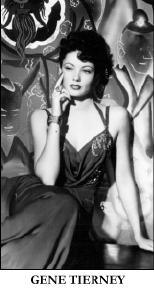
If Dante’s Inferno [reviewed here ] literally takes the viewer into the various levels of Hell where damned souls writhe in eternal agony, von Sternberg’s mesmerizing drama set in a gambling casino in Shanghai’s Red Light district takes a metaphorical spin on the nether region that is infinitely more terrifying than the silent film’s version.
Colton, author of the play on which the film was based, was also the author of Miss Sadie Thompson, which first made it to the screen in 1928 as Rain.
If the earlier play posed problems for the Hollywood censors in the pre-code era, The Shanghai Gesture was even more problematic, with a central character (Mother Goddam) the proprietor of a notorious establishment, who introduces her daughter (Poppy) to drugs and prostitution as revenge on her English father.
The result was considered unfilmable in a more lenient Hollywood, and only made it to the screen with a much watered down but still pungent screenplay years after the installation of the restrictive Production Code.
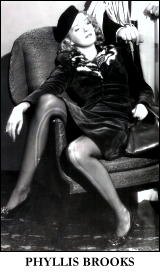
Ona Munson, who memorably played Belle Watley, an Atlanta madam, in Gone with the Wind, was persuaded with great difficulty by the director to take on a part that, even with the prostitution element eliminated, could not help but remind audiences of her celebrated role.
Von Sternberg surrounded the newly christened Mother Gin Sling with a first-rate cast, with her daughter played by the young, promising Gene Tierney, her ex-husband by the notable Walter Huston, and a supporting cast of seasoned character actors, some playing against type (as in the case of Eric Blore), others (like Victor Mature, early in his career) etching indelible portraits of the employees and habitues of the gambling house.
The movie has languished in obscurity in recent years, but with a fair amount of notoriety connected to it. The overhead shots of the gambling den that spirals down like steps toward Hell are brilliantly realized, while the great scene at Mother Gin Sling’s climactic dinner party beginning as an elegantly orchestrated party of revenge, quickly unravels as the revelation of old truths, long buried, leads to the violent, tragic conclusion of this disturbing film.
Sun 9 Aug 2009
A 1001 MIDNIGHTS Review
by Thomas Baird:
MARGERY ALLINGHAM – Death of a Ghost. Doubleday Crime Club, US, hardcover, 1934. Previously published in the UK by William Heinemann, hc, 1934. Reprinted many times, in both hardcover and paperback, including Penguin #503, pb,1942, in dust jacket; Penguin C379, pb, 6th pr., 1966; Bantam, pb, 5th pr., 1989 (all shown).
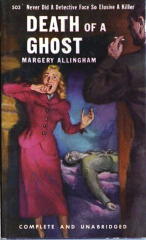
Margery Allingham was one of the three major Englishwomen mystery writers of the “Golden Age of Detective Fiction” — the other two, of course, being Agatha Christie and Dorothy L. Sayers.
High literary quality marks her books, some of which have been compared to mainstream novels. Her plots are varied and interesting, portraying such subcultures of the time as the publishing industry, high-fashion houses, the world of the theater, and the life of the aesthete.
Allingham’s plots are not based on razor-sharp surprises, as Christie’s are, but rather are known for their eccentricity. Unlike Sayers, Allingham produced a literate story without precious excesses, without intellectual showing off. Her characters are human, if upper class, and even the minor ones are fully drawn.
Allingham’s consummate creation is the suave sleuth Albert Campion. He comes with a mysterious background of royalty, or at least nobility, but he is “an amateur who never used his real name and title.” Campion confronts international criminal conspiracies, greedy friends and relations, overweening egos turned to madness, and spy threats against his beloved England.
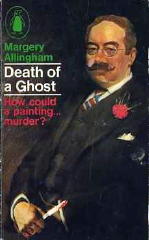
Ultimately, though, Allingham’s best books depend on the investigation and deduction of human motives and psychology for their solutions. Very early tales present Albert Campion as the action-adventurer, popular at that time. In Death of a Ghost, he becomes more the suave dilettante who senses the subtle psychology in suspense situations.
Campion is notable for having no outstanding eccentricities (in contrast to many other Golden Age detectives). He has a vacant face with horn-rimmed spectacles that give him “owlish gravity.” A sign of deep emotion is his taking off his glasses.
In this novel the plot concerns an odd will left by an artist who died years before. The artist, John Lafeadio, considered himself the foremost painter of his age. He left behind a tangled menage of wife, Belle; family; and sycophants. The will provides that each year a painting be taken from a secret cache and exhibited at an exclusive art show in order to maintain Lafcadio’s artistic immortality.
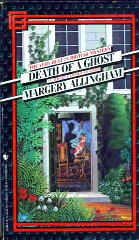
During the current exhibit, the lights fail, and when they’re turned back on, another painter is found a corpse. A short time later, another minor member of the menage is also killed.
Campion wades through the art group’s murky crosscurrents of emotion and suspicion, exploring alibis and evasions. The police are represented by Inspector Stanislaus Oates, “the shrewdest and at the same time most kindly member of the Yard.”
Official and amateur come to agree on the killer, but getting the proof means Campion must face a final, ingenious attempt on his own life.
———
Reprinted with permission from 1001 Midnights, edited by Bill Pronzini & Marcia Muller and published by The Battered Silicon Dispatch Box, 2007. Copyright © 1986, 2007 by the Pronzini-Muller Family Trust.
Sun 9 Aug 2009
Posted by Steve under
Reviews[4] Comments
A Review by MIKE TOONEY:
MARGERY ALLINGHAM — Mr Campion and Others. Penguin, paperback, 1950. Previously published in hardcover by William Heinemann (UK) with slightly differing contents. Reprinted many times.
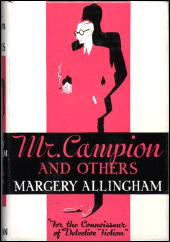
Some mystery authors have made their detectives as eccentric as possible (and sometimes beyond possibility) — Sherlock Holmes and Sir Henry Merrivale come immediately to mind — while other authors have gone entirely the other way, e.g., Father Brown. With Albert Campion, Margery Allingham seems deliberately to have created a character to rival Chesterton’s sleuth in the area of non-descriptness but still possessing exceptional intelligence.
Albert Campion seems amphibious, equally at home among the very rich and the riffraff; like Clark Kent he moves among the throng, always ready to hop into the nearest phone booth when an emergency arises.
His character is also comparable to certain fish species: Most of the time he is a remora, cruising with the sharks and on the lookout for whatever scraps of information or acquaintances that could prove useful in future enquiries; very seldom, he is himself a shark, when he must force a resolution to an issue of great personal or social importance. (In only one of the stories in this collection is he seen with a gun, and even then he doesn’t use it.)
To his many high society friends, he is instantly trustworthy; even a person who has just met him feels that way: “… a great many people do take you into their confidence, I believe?” To which he responds: “I’m as secret as the grave.”
Margery Allingham’s style, at least in these stories, is at or above average for the period (and considerably above average for today). She is literate without being literary, in the pejorative sense of that word.
In contrast with Mr. Campion, many of her minor characters are well described and memorable; her powers of description of places frequently find expression in some passages of what these days is referred to as “fine writing,” but they do not in any way impede the narrative flow — rather, they enhance the story by being relevant to the action.
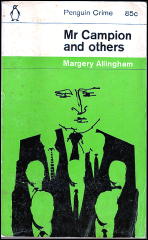
I. “The Widow” (The Strand, April 1937)
It begins: “The second prettiest girl in Mayfair was thanking Superintendent Stanislaus Oates for the recovery of her diamond bracelet and the ring with the square-cut emerald in it, and Mr. Campion, who had accompanied her to the ceremony, was admiring her technique.”
Funny how one thing can lead to another, isn’t it? First, Mr. Campion is using his refined palate to sample rare wines on behalf of his godson; then he is enlisted by Mr. Thistledown, a venerable vintner, to travel incognito to a “cold and sleepy village” on the Norfolk coast to watch “an experiment” being given by a man of “odd, Mephistophelean appearance.”
Next, after witnessing what must be a scientific miracle, Campion twigs on to a brilliant scam; and, in so doing, he also solves the subsidiary mystery of a newspaper ad seeking the services of a children’s entertainer.
In vino veritas, indeed! But there is one unresolved mystery: If Miss Peterhouse-Vaughn is the second prettiest girl in Mayfair, then who is the first?
II. “The Name on the Wrapper” (The Strand, March 1938; EQMM, November 1947)
It begins: “Mr. Albert Campion was one of those useful if at times exasperating people who remain interested in the world in general at three o’clock on a chilly winter’s morning. When he saw the overturned car, dark and unattended by the grass verge, therefore, he pulled up his own saloon and climbed out on to the road, whose frosty surface was glistening like a thousand diamonds.”
Returning home from a dinner party, Mr. Campion comes across the aforementioned automobile and a jewel-encrusted ring, not realizing he has encountered the aftermath of a major crime perpetrated among the very rich set. Superintendent Oates is on the case, and he calls for Campion; after all, he says, “You’re our Society expert.”
So, after some trolling among the haut monde, the “expert” snags a reluctant debutante whose appealing lack of guile eventually leads him to the thief, a Raffles wannabe with the skills, but not the good luck, to pull it off. The search is not without its rigors for Campion, however:
“He paused. The alarm had died out of her eyes and she even looked wanly amused. He was relieved. Idiotic conversation, although invaluable, was not a luxury which he often permitted himself now that the thirty-five-year-old landmark was passed.”
III. “The Hat Trick” (The Strand, October 1938; EQMM, January 1946 as “The Magic Hat”)
It begins: “Mr. Campion received the hat as a sentimental tribute. Mrs. Wynyard pressed it into his hand at her farewell party at the Braganza on the night before she sailed home to New York.”
Peter Herrick is gobsmacked with Prudence Burns, and she is inclined to reciprocate; but then there is Norman Whitman, whose influence with Prudence’s father is enormous and who is much too willing to serve as Mr. Burns’ entree into the glittering world of high society.
Furthermore, consider Mr. Campion’s silly little hat which, to his surprise, exercises an influence on Mr. Burns and restaurant waiters that is all out of proportion to its apparent charm. It isn’t long before Campion must admit: “… I’m afraid we’ve stumbled on the great forefather of all confidence tricks.”
IV. “The Question Mark” (The Strand, January 1938; EQMM, Fall 1941)
It begins: “When Miss Chloe Pleyell became engaged to Sir Matthew Pearing, K.C., Mr. Albert Campion crossed her name off his private list entitled ‘Elegant Young Persons Whom I Ought to Take to Lunch’ and wrote it in neatly at the foot of his ‘People I Must Send Christmas Cards to’ folder.”
Chloe Pleyell — “She was beautiful and she was charming and at heart a dear, he reflected, but unfortunately hardly safe out” — inadvertently creates something of a dust-up when she hires a “private enquiry agent” to “enquire” about her fiance; what he turns up could put somebody in prison, if the physical evidence is to be believed.
Mr. Campion comes to the rescue and nails a master thief (“The Question Mark”) when he sorts out “161” from “191.”
V. “The Old Man in the Window” (The Strand, October 1936)
It begins: “Newly appointed Superintendent Stanislaus Oates was by no means intoxicated, but he was cheerful, as became a man celebrating an important advance in a distinguished career, and Mr. Campion, who sat opposite him at the small table in the corner of the chop-house, surveyed the change in his usually taciturn friend with interest.”
Mr. Campion and the new superintendent are at dinner one evening and together witness the usual results of a love triangle, as Denise Warren breaks up with her fiance, Arthur March, when she arrives with Rupert Fielding, a young surgeon. Six weeks later a very senior member of Campion’s club, the Junior Greys, is found dead in his usual chair at that establishment.
Are the two events somehow related? Indeed, they are: “… where’s the crime?” asks Oates; “Well, it’s murder, you know,” replies Campion as they stand over the corpse. But more eyebrows than just Mr. Campion’s are raised when the victim decides to come back from the dead ….
VI. “The White Elephant” (The Strand, August 1936)
It begins: “Mr. Campion, piloting his companion through the crowded courtyard at Burlington House, became aware of the old lady in the Daimler, partly because her chauffeur almost ran over him and partly because she gave him a stare of such vigorous and personal disapproval that he felt she must either know him very well indeed or have mistaken him for someone else entirely.”
Chief Detective-Inspector Stanislaus Oates tells Campion, “Some society bit is mixed up in this somewhere, I’m sure of it.” The “society bit” to whom Oates ignorantly refers is Juliet Fysher-Sprigge, a good friend of Mr. Campion; “this” concerns a series of jewel robberies that the police are convinced were pulled off by The Sparrow, “a sleek, handsome chap with an insufferable manner.”
But surely Lady Florence, Dowager Countess of Marle, “the old lady in the Daimler,” also couldn’t be mixed up in a smuggling ring with her White Elephant Society charity, could she? Before this case is closed, Campion must not only decode the clue of common British Christian names but also survive a shoot out: “A bullet took Mr. Campion’s hat from his head … the darkness was streaked with fire ….”
VII. “The Frenchman’s Gloves” (The Strand July 1938; EQMM August 1947 as “The Case of the Frenchman’s Gloves”)
It begins: “Mr. Albert Campion was considering the hundred and fifteenth unintelligible oil painting under the muslin-shaded lights of the Excelsior Gallery’s stuffiest room, and wondered if it was honest reaction or merely age which made him yearn for an occasional pair of gluey-eyed, human-faced dogs by old Mr. Landseer. A pathetic sigh at his shoulder recalled him to his duty as a nursemaid. He glanced at Felicity apologetically.”
What if Shakespeare had had old Capulet, Juliet’s father, go missing at the end of Act I of his famous play? There is certainly friction between this Capulet (M. Edmond Gerard of Vaux, France) and these Montagues (the Roundels of Cornwall) when Madeleine Gerard and Henry Roundel express a desire to wed, so a conciliatory luncheon is arranged; but when the elder Gerard, a dealer in precious stones and a man renowned for his reclusiveness, checks into his London hotel, it’s virtually the last anyone sees of him — except, that is, for the visit he pays to a branch office to commune with some rubies…
Mr. Campion and Superintendent Oates smash a jewelry theft ring when Campion tumbles to the significance of one glove being dirty while the other is clean — and immeasurable assistance is provided by The Elephant with two legs.
VIII. “The Longer View” (The Strand, August 1938; EQMM, October 1946 as “The Crimson Letters”)
It begins: “On the day that the entrancing Beatrix Lea married her famous leading man, Mr. Albert Campion took Mr. Lance Feering to re-visit the happy scenes of Mr. Feering’s youth. The expedition was purely remedial.”
While nosing about an old flat that Lance Feering had lived in during his salad days, Lance and Mr. Campion come across something remarkable: inside a cupboard they find, in six-inch-high crimson letters, the words “O let me out let me out let me out let me out” and a name, “Janey”; Campion discovers that the writing was done in lipstick less than forty-eight hours previously.
It’s enough to start him on a trail that will ultimately lead to a gang of kidnappers and one “tough” little girl.
IX. “Safe as Houses” (The Strand , January 1940; EQMM, March 1944)
It begins: “Mr. Albert Campion came gingerly down the steep staircase of the White Lion Inn at Little Chittering in Sussex with two important queries occupying his mind. One was the comparatively simple question, where was the bar, and the other a more philosophical matter concerning the Blood Tie, or how much need the average man endure for his relations before he is entitled to sneak quietly home to London and go to earth in his club?”
For Mr. Campion it seems to be just a wild goose chase — no, make that a wild peacock chase. His formidable Great Aunt Charlotte is convinced that an interloper has invaded her sanctum, her drawing-room, and left unmistakable traces of his incursion: “There was the mark of a glass on my walnut lowboy,” she said at last, her voice dropping at the enormity of the crime. “An odious white ring; I saw it at once. Then there was the cigarette ash in the coal scuttle and of course the notepaper…” — notepaper inscribed with an address: “Grey Peacocks, Little Chittering.”
So here he is, one hundred and forty miles from home; but the locals have never heard of a house called the Grey Peacocks, and the investigation is going nowhere when Mr. Campion encounters “one of the prettiest girls he had ever seen in a long and by no means misspent youth” who is also looking for the same mythical residence — and isn’t that enough of a reason to revive Campion’s flagging interest in this seemingly trivial and tiresome mystery?
For not only is there more than meets the eye in it, but also considerably less.
X. “The Definite Article” (The Strand, October 1937; EQMM, November 1942)
It begins: “‘My dear man,’ said Old Lady Laradine, her remarkable voice penetrating the roar of the Bond Street traffic with easy mastery, ‘don’t you think you’re going to get away from me once I’ve settled down to a gossip. Come back here at once. Dorothea has got her girl safely engaged to Lord Petering, I see. You know him, don’t you? Tell me, do you approve?'”
Mr. Campion has scarcely evaded gossipy Old Lady Laradine when he falls into the clutches of Superintendent Oates. A young New York socialite has apparently committed suicide, and the American feds think her blackmailer — if indeed she was being blackmailed — could be in England.
“I’ll tell ’em I’ve put a Society expert on the job,” Oates said, grinning. “That’ll please ’em and keep ’em quiet for a bit. There you are. You came in here looking for something to do and now you’ve got it. There’s a little miracle for you. Pull that off.”
Oh, Campion pulls off the little miracle, all right; but first he must endure another harrowing encounter with Lady Laradine, divine the actions of a sinister psychometrist, and correctly explain the absence of one of the smallest words in the English language — the definite article.
XI. “The Meaning of the Act” (The Strand, September 1939; EQMM, May 1945)
It begins: “‘Trivial, vulgar, pettifogging, puerile, footling. At times even dirty,’ said Lance Feering, taking up his glass. ‘I don’t want to be hypercritical old boy, but that’s how I see this life of yours. It repels me. My stomach turns at it. I gag … You see what I mean?'”
“‘The light is filtering through,’ agreed Mr. Albert Campion affably, as he flattened himself against the ornate tiles behind him. ‘Criminology does not appeal to you tonight.'”
Marguerite Tiffin is concerned about her septuagenarian father, Dr. Clement Tiffin, “a distinguished bird, you know … a recluse, a famous man, an Egyptologist of world renown.” So when he starts “sneaking out of the house like an adolescent and trotting off to music halls alone, all up and down the country, performance after performance,” she could be forgiven for thinking that he’s at long last entered his dotage.
She prevails on her good friend Lance Feering, who in turn prevails on his good friend Mr. Campion. Soon the old professor is assaulted — but why would someone object so violently to an old guy ogling an exotic dancer doing her performance on a public stage?
Campion finally comes to understand why Dr. Tiffin’s name reminds him of crossword puzzles (it has to do with Room OB 40, naturally); paradoxically, Mr. Campion has far less difficulty understanding a man who says things like, “I caught a shice and did a carpet in the spring. Had to come to town without a coal. But a denar here and a denar there soon mounts up, you know, and I’m in clover. By the way, this is my monkery, so who’s your party?”
XII. “A Matter of Form” (The Strand , May 1940; EQMM, January 1945)
It begins: “‘The trouble with crime to-day,’ remarked Superintendent Stanislaus Oates seriously, ‘is that one almost gets too much of it, if you see what I mean.’
“‘Absolutely,’ murmured his companion with solemn, not to say owlish, gravity. ‘The word you’re searching for is “common,” isn’t it?'”
Brian Green is enamored of Miss Susan Chad; Susan, in turn, is enamored of brains — something, poor child, she seems bereft of. Small wonder she becomes the victim of a criminal who, in Mr. Campion’s words, has “more brains than average”, a thief who, with a little more self-control and energy, could prove unstoppable — but the frog who would a-wooing go should really beware of the fine fat duck with a set of handcuffs ….
XIII. “The Danger Point” (The Strand, June 1937; EQMM, May 1948)
It begins: “Mr. Albert Campion glanced round the dinner table with the very fashionable if somewhat disconcerting mirror top and wondering vaguely why he had been asked, and afterwards, a little wistfully, why he had come.”
Mr. Campion attends a posh dinner party attended by the brother of an old friend, Geoffrey Painter-Dell; by a young lady Geoffrey has warm feelings for, Petronella Andrews; and Leo Seazon, who “was a natural intriguer and had a finger in every pie.”
At the time, Campion doesn’t recognize what Petronella has hung around her neck: an elegant pearl necklace that had been stolen seven years ago from Geoffrey’s current employer, Lady (Cinderella) Lamartine. The fact that Petronella is in possession of stolen property could result in ruinous scandal for the two young lovers, something that isn’t lost on the treacherous Leo Seazon.
To further complicate matters, the necklace is stolen yet again; it’s up to Mr. Campion to quash the whole unwholesome affair before Cinderella gets on the ball.
Sat 8 Aug 2009
Posted by Steve under
Reviews[4] Comments
THREE BY ROBERT BLOCH
Reviewed by Dan Stumpf:
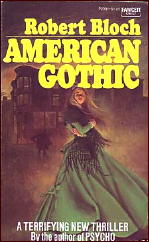
American Gothic (1974) about a series of murders-for-profit set in Chicago of 1893, is supposedly true, but that don’t make it much good. The characters and cliff-hangings are all fairly standard, and the ending looks to have been swiped from Mystery of the Wax Museum (1933). Pretty disappointing from the Master of Menace.
It was a younger, hungrier and harder-working Bloch who turned out Shooting Star / Terror in the Night (Ace Double, 1958). Night collects Bloch stories, mostly from Manhunt and other mystery mags from the 1950s, dealing with creepy crime and poetic justice, and if the poetry is usually just doggerel, the crime is creepy enough.
Shooting Star is a more memorable effort, a standard PI yarn, maybe, but done with shrewd insight into the vagaries of Hollywood deal-making and the marketing of fame.
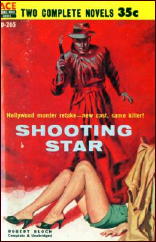
The protagonist, Sam Clayburn, is a once-successful agent, now down on his luck, eking out a living writing True Crime stories, who gets hired to investigate the scandalous case of a murdered cowboy star (this was written in 1958, remember) whose old movies can’t be sold to TV because his death was linked to Marijuana (1958, remember).
There’s nothing very remarkable here, nor very creepy either, but Bloch deals the hard-boiled cards very ably, turning up the requisite hands of mysterious warnings, dangerous blondes, shots in the dark, beatings, cops, et al, set in a milieu of nervous celebrities and phony glamour (as opposed to real glamour, I guess).
Lines like “Keep your nose clean — before someone taps it with a spade.” and “Her pajamas tended to gape. So did I.” — help things along to their predestined end, and left me wishing Bloch had done more in the standard PI line
Bibliographic Data:
American Gothic. Simon & Schuster, hardcover, 1974. Paperback reprints: Fawcett Crest P2391, 1975; Tor, 1987; I Books, 2004.
Shooting Star. Ace Double D-265, paperback original, 1958. Hard Case Crime, pb reprint, 2008, bound with Spiderweb.
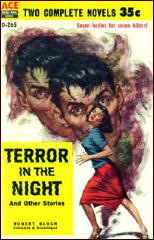
Terror in the Night and Other Stories. Ace Double D-265, paperback original, 1958. Story collection:
● A Good Imagination. Suspect Detective Stories, January 1956.
● Luck Is No Lady. Alfred Hitchcock Mystery Magazine, August 1957.
● Man with a Hobby. Alfred Hitchcock Mystery Magazine, March 1957.
● The Real Bad Friend. Mike Shayne Mystery Magazine, February 1957.
● String of Pearls. The Saint Detective Magazine, August 1956.
● Terror in the Night. Manhunt, February 1956.
● Water’s Edge. Mike Shayne Mystery Magazine, September 1956.
« Previous Page — Next Page »







